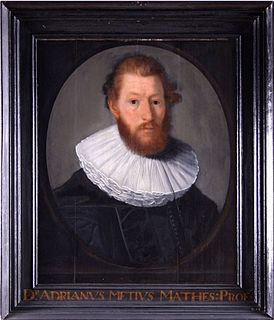This page is based on this
Wikipedia article Text is available under the
CC BY-SA 4.0 license; additional terms may apply.
Images, videos and audio are available under their respective licenses.
Metis or Métis may refer to:

Year 1571 (MDLXXI) was a common year starting on Monday of the Julian calendar.

Alkmaar [ˈɑl(ə)kmaːr] (listen) is a city and municipality in the Netherlands, located in the province of North Holland. Alkmaar is well known for its traditional cheese market. For tourists, it is a popular cultural destination.

Hans Lippershey, also known as Johann Lippershey or Lipperhey, was a German-Dutch spectacle-maker. He is commonly associated with the invention of the telescope, because he was the first one who tried to obtain a patent for it. It is, however, unclear if he was the first one to build a telescope.
A hind is a female deer, especially a red deer.
The year 1635 in science and technology involved some significant events.

Fabricius is a lunar impact crater that is located within the northeast part of the walled plain Janssen. Attached to the north-northwest rim is the slightly larger cater Metius. Fabricius has multiple central peaks that rise to 0.8 km, with a rugged rise to the northwest running north–south. The rim is lumpy and somewhat distended, most noticeably to the southwest and south. It is 78 kilometers in diameter and 2,500 meters deep. It is from the Eratosthenian period, 3.2 to 1.1 billion years ago. It is named after David Fabricius, a 16th-century German astronomer.

Janssen is an ancient impact crater located in the highland region near the southeastern lunar limb. The entire structure has been heavily worn and is marked by many lesser crater impacts. The outer wall is breached in multiple locations, but the outline of the crater rim can still be observed. The wall forms a distinctive hexagonal shape upon the rugged lunar surface, with a slight curvature at the vertices.

Rheita is a lunar impact crater located in the southwestern sector of the Moon. It was named after Czech astronomer and optician Anton Maria Schyrleus of Rheita. It lies to the northeast of the crater Metius, and northwest of Young. The southwestern rim overlies the edge of Vallis Rheita, a long lunar valley stretching for over 200 kilometers on a line running northeast to southwest. At its widest the valley is 25 kilometers wide and a kilometer deep.

Baillaud is a lunar impact crater that is located near the north limb of the Moon. The rim of the crater has been eroded and worn by a long history of impacts, leaving a hilly ridge surrounding the interior. The crater Euctemon is intruding into the rim to the northeast, and the rim bulges outward to the northwest. At the south end of the crater is a gap connecting to the lava-flooded surface to the south.

Brenner is an old lunar impact crater that lies in the rugged southeastern part of the Moon's near side. It is named after the Serbian-Austrian astronomer Spiridon Gopčević. It is located within one crater diameter northwest of the crater pair Metius and Fabricius.

Lunar craters are impact craters on Earth's Moon. The Moon's surface has many craters, almost all of which were formed by impacts.

The Astronomer is a painting finished in about 1668 by the Dutch painter Johannes Vermeer. It is oil on canvas, 51 cm × 45 cm, and is on display at the Louvre, in Paris, France.
The year 1571 in science and technology included a number of events, some of which are listed here.

Adriaan Adriaanszoon, called Metius,, was a Dutch geometer and astronomer born in Alkmaar. The name "Metius" comes from the Dutch word meten ("measuring"), and therefore means something like "measurer" or "surveyor."

Adriaan Anthonisz (1527–1607) was a Dutch mathematician, surveyor, cartographer, and military engineer who specialized in the design of fortifications. As a mathematician Anthonisz discovered in 1585 the ratio of a circle's circumference to its diameter, which would later be called pi.












